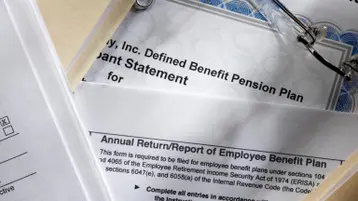What's an HSA? Employer's Guide to Health Savings Accounts

Table of contents
- 1.What is an HSA?
- 2.What can employees use an HSA for?
- 3.Section 1: Understanding HSA contributions
- 4.Average employer and employee contributions to HSAs
- 5.Rules affecting employer contributions to HSAs and HRAs
- 6.Contributions to FSAs
- 7.Understanding contribution variability and IRS guidelines for HSAs, HRAs and FSAs
- 8.HSA account setup and eligibility
- 9.Can spouses who work for the same company both contribute to a joint HSA via payroll deductions?
- 10.Are contributions to HSA considered income?
- 11.Does a company automatically get an HSA with an HDHP?
- 12.Section 3: Setting up and managing an HSA
- 13.HR fast facts: Getting started with HSAs
- 14.HR fast facts: What are the eligibility requirements for an HSA?
- 15.Your guide to HSAs
What is an HSA? Well, it's one of your best assets when it comes to comprehensive and flexible health care solutions for your employees. In this comprehensive guide to health savings accounts (HSAs), we'll cover:
- What is an HSA?
- What can employees use an HSA for?
- Understanding HSA contributions
- HSA setup and eligibility
- Tax considerations
What is an HSA?
A health savings account (HSA) is a tax-advantaged medical savings account available to taxpayers in the United States who are enrolled in high-deductible health plans (HDHPs). HSAs allow individuals to save and pay for various medical expenses with pre-tax dollars, making health care expenses more affordable.
Contributions made to an HSA are not subject to federal income tax at the time of deposit. An HSA balance can be used to pay for qualified medical expenses at any time without federal tax liability, meaning the employee can save pre-tax dollars.
Key features of an HSA are its flexibility and the benefit of funds rolling over if they are not spent. This is different from a flexible spending account (FSA), which has a "use it or lose it" policy. Additionally, HSA money can be invested and the earnings are tax-free. After the age of 65, individuals can withdraw funds for non-medical expenses which are subject to income tax. HSA funds thus serve as a powerful tool for managing out-of-pocket costs and saving for future medical and dental expenses.
What can employees use an HSA for?
When you contribute to an HSA, you're putting tax-free earnings into an account where it can be accessed for:
- Medical expenses, prescription medications, medical equipment and mental health services. It covers deductibles, copayments and coinsurance for medical services and even over-the-counter medication with a doctor's prescription. Purchase items like crutches, wheelchairs and bandages. Access therapy, counseling and psychiatric services.
- Dental and vision services and care. This includes dental cleanings, fillings, crowns, and orthodontics and expenses for eye exams, glasses, contact lenses and laser eye surgery.
- Physical therapy, as in expenses for physical rehabilitation after injuries or surgeries.
- Preventive care, such as routine health screenings and other preventive services.
- Long-term care services and health insurance premiums: expenses related to long-term care, under certain conditions. In some cases, HSA funds pay premiums for health insurance, particularly during unemployment or for COBRA.
- Medical expenses for dependents. An HSA can cover qualified medical expenses for your dependents, even if they are not covered by your high-deductible health plan.
Section 1: Understanding HSA contributions
Both employers and employees can make contributions to HSAs. In fact, based on the findings discussed below, contributions to employee HSA accounts are on the rise. As you'll see, there are different governing agencies and rules for different types of savings accounts. We recommend that you meet with your HSA provider or a financial advisor for detailed information on other qualified medical expenses and guidelines.
Average employer and employee contributions to HSAs
According to the 2022 Year-End Devenir HSA Research Report, 26% of HSA dollars contributed to an account came from an employer. The average contribution was around $869 to HSAs for individual employees.
Employee contributions made up 63% of all HSA dollars contributed to an account. The average contribution was $2,147.
The key takeaway from Devenir’s research is that HSA contribution and withdrawal activity remain strong. In total, account holders contributed $47 billion to their accounts in 2022 (up 11% from the year prior). They withdrew $34 billion from their accounts during the year (up 11% from 2021). It continues to be a popular, helpful tool for employees who want flexibility in managing their health care.
Rules affecting employer contributions to HSAs and HRAs
HSA (2023): Maximum total contributions from both the employer and the employee are $3,850 for single employees, or $7,750 for families. There’s an additional catch-up contribution of $1,000 for participants age 55 and older.
HRA (2023): There are no limits to the amount your organization can contribute to an employee’s HRA. All funding for HRAs is contributed by the employer.
Contributions to FSAs
The Affordable Care Act (ACA) has had a big impact on FSAs, making the contribution statistics for flexible spending accounts inconclusive.
As of 2023, the annual contribution limit for medical FSAs is $3,050.
Employer contributions don’t always count toward that limit, such as employer match contributions. You can consult a tax professional to determine what rules apply to specific situations for your organization and its employees.
Also, note that this limit is subject to inflation adjustments each year. The ACA restricted the use of FSA funds for over-the-counter medications, requiring a prescription for reimbursement. This introduced new reporting obligations for employers.
In terms of flexibility, employers can offer certain exceptions to these rules. They can choose to allow employees to carry over up to $610 of unused FSA funds to the next year. Alternatively, they can provide a grace period of up to 2.5 months after the end of the plan year for employees to use their remaining FSA funds. These options are designed to reduce the "use-it-or-lose-it" nature of FSAs, giving employees more leeway in managing their healthcare expenses.
FSAs used for childcare expenses are subject to a different set of rules and remain capped at $5,000.
Understanding contribution variability and IRS guidelines for HSAs, HRAs and FSAs
Contributions to HSAs and health reimbursement arrangements (HRAs) can vary significantly, depending on several factors. For HSAs, the contribution limits are set by the Internal Revenue Service. They are subject to annual adjustments, with additional catch-up contributions allowed for individuals age 55 and older.
HRA contributions, on the other hand, have no set limits, as they are entirely funded by employers and can differ based on the employer's policies. FSAs have more complex rules, with annual contribution limits and options for carryover or grace periods, as set by employers.
The amount that employers contribute to these accounts can also vary widely by region and industry. Variations reflect differing local economic conditions and industry-specific health care needs. To navigate these complexities, you'll need a better understanding of the IRS guidelines on fringe benefits, including contributions to HSAs, HRAs and FSAs. For detailed information and the latest updates, consult the IRS's Employer's Tax Guide to Fringe Benefits.
HSA account setup and eligibility
One of the primary benefits of HSAs is that they reduce an employee's taxable income. But again, restrictions exist regarding the total allowable contributions. Additionally, there are strict guidelines regarding how a married working couple must handle HSAs.
Can spouses who work for the same company both contribute to a joint HSA via payroll deductions?
Spouses who work for the same company can both contribute to HSAs, but they have to do so through separate individual accounts. The IRS mandates that health savings are strictly individual accounts; joint HSAs between spouses are not permitted. Each spouse can open and contribute to their own HSA, even if they are employed by the same company and eligible for payroll deductions.
Despite having individual HSAs, spouses can use the funds in their accounts for each other's qualified medical expenses. This flexibility allows spouses to effectively share the financial resources in their HSAs for health care costs. When it comes to contribution limits, if either spouse has family coverage under an HDHP, the IRS family contribution limit applies. This limit is shared between the two HSAs. For instance, if the family contribution limit is $7,750, both spouses must ensure their combined contributions to their respective HSAs do not exceed this amount.
Are contributions to HSA considered income?
Employee contributions to HSAs are made with pre-tax dollars, meaning they are not considered taxable income. This is one of the key benefits of HSAs, as it allows employees to reduce their taxable income. Employer contributions are not included in the employee's gross income and are not subject to federal income tax.
However, there are strict limitations on the total contributions to an HSA. Exceeding these limits can result in tax penalties. As mentioned above, for 2023, the total contribution limit is $3,850 for individual coverage. The limit for family coverage is $7,750, with an additional $1,000 catch-up contribution allowed for individuals age 55 and older. If contributions exceed these limits, the excess amount is subject to a 6% excise tax. To avoid these penalties and for detailed guidance on contributions and rules, the IRS Publication 969 is a comprehensive resource.
Does a company automatically get an HSA with an HDHP?
No, a company does not automatically get an HSA when offering an HDHP. While HDHPs are a prerequisite for HSAs, employers are not obligated to offer HSAs to their employees. Offering an HSA can be beneficial for both employers and employees due to its tax advantages. Contributions made by employees to an HSA are pre-tax, reducing their taxable income, and the funds grow tax-free. When an employer contributes, they, too, benefit, as contributions to HSAs can reduce employer payroll taxes.
For comprehensive information on HSAs and HDHPs, including tax implications and guidelines, employers and employees can refer to the IRS website. IRS Publication 969, "Health Savings Accounts and Other Tax-Favored Health Plans" provides detailed insights into the rules and benefits of HSAs. Additionally, the IRS website offers updated information on contribution limits and qualifications for HSAs.
Section 3: Setting up and managing an HSA
For individuals who have a high deductible health plan and no other health coverage, setting up an HSA is fairly simple. The process is managed by the employer.
HR fast facts: Getting started with HSAs
Setting up a HSA typically involves the following steps, and only administrators with HR permissions can initiate the process:
- Eligibility verification: The administrator must first verify that the individual is enrolled in a qualifying HDHP.
- Selecting a provider: The company chooses an HSA provider. This might involve comparing various financial institutions based on fees, investment options and ease of use.
- Gathering information: The administrator collects necessary information from the employee, including personal identification and tax information.
- Account setup: The administrator, using their HR permissions, sets up the HSA account with the chosen provider. This process includes filling out the required documentation and ensuring compliance with all IRS regulations.
- Contributions and maintenance: After setup, the employer and employee can start making contributions to the HSA. The administrator oversees the contributions to ensure they adhere to the annual IRS contribution limits and manages any changes or updates to the account.
HR fast facts: What are the eligibility requirements for an HSA?
To be eligible for an HSA, an individual must meet specific criteria defined by the IRS:
- Enrollment in a high deductible health plan (HDHP): The individual must be covered under a qualifying HDHP.
- No other health coverage: They should not have any other health coverage except what is permitted under the IRS guidelines.
- Not enrolled in Medicare: Individuals enrolled in Medicare are not eligible for an HSA.
- Not claimed as a dependent: They cannot be claimed as a dependent on someone else's tax return.
The IRS also sets specific requirements for HDHPs, including minimum deductibles and maximum out-of-pocket expenses.
For example, for 2023, the minimum annual deductible for an HDHP is $1,500 for individual coverage and $3,000 for family coverage. The maximum out-of-pocket expenses are capped at $7,500 for individual coverage and $15,000 for family coverage. These figures are subject to annual adjustments. For the most current requirements and detailed information, refer to the latest IRS guidelines.
Your guide to HSAs
TriNet's platform and services can significantly help in managing HSAs for employees. TriNet provides access to both FSAs and HSAs, enabling employees to save money on everyday expenses through tax-advantaged accounts
TriNet's comprehensive approach to HSAs combines ease of management with flexible contribution options. This makes it an effective solution for both employers and employees looking to leverage the benefits. Find out today how TriNet can help your business manage HSAs today.

TriNet Team
Table of contents
- 1.What is an HSA?
- 2.What can employees use an HSA for?
- 3.Section 1: Understanding HSA contributions
- 4.Average employer and employee contributions to HSAs
- 5.Rules affecting employer contributions to HSAs and HRAs
- 6.Contributions to FSAs
- 7.Understanding contribution variability and IRS guidelines for HSAs, HRAs and FSAs
- 8.HSA account setup and eligibility
- 9.Can spouses who work for the same company both contribute to a joint HSA via payroll deductions?
- 10.Are contributions to HSA considered income?
- 11.Does a company automatically get an HSA with an HDHP?
- 12.Section 3: Setting up and managing an HSA
- 13.HR fast facts: Getting started with HSAs
- 14.HR fast facts: What are the eligibility requirements for an HSA?
- 15.Your guide to HSAs






